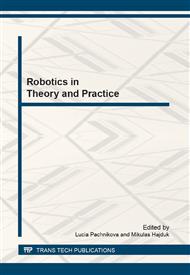[1]
Abakumov A. M., Voronin P. А., Denkevic V. А. Mathematical model of the process of turning with control of straight feed and spindle rotation speed. NIImash. – Dep. V VINITI, 1878, vol. 2.
Google Scholar
[2]
Abakumov A. M., Taranenko V. А. Mathematical model of the process of turning of parts with low rigidit. Identyfikacja i avtomatizacya technologitscheskich procesov w maschinostroyenii: Sb. nautsch. tr, Kujbytschev, 1988, pp.67-69.
Google Scholar
[3]
Ratchev S, Liu S, Huang W, Becker A A. A flexible force model for end milling of low-rigidity parts. Journal of Materials Processing Technology. Proceedings of the International Conference in Advances in Materials and Processing Technologies. 2004; 153-154: 134-138.
DOI: 10.1016/j.jmatprotec.2004.04.300
Google Scholar
[4]
Świć A, Taranenko W. Adaptive control of machining accuracy of axial-symmetrical low-rigidity parts in elastic-deformable state. Eksploatacja i Niezawodnosc – Maintenance and Reliability 2012; 14 (3): 215-221.
Google Scholar
[5]
Świć A, Taranenko W, Szabelski J.: Modelowanie układów dynamicznych szlifowania wałów o małej sztywności/Modelling dynamic systems of low-rigid shaft grinding. Eksploatacja i Niezawodność – Maintenance and Reliability 2011, 2 (50), s. 13 – 24.
Google Scholar
[6]
Taranenko W., Świć A. Technology of profiling machine parts with low rigidity. Wydawnictwo Politechniki Lubelskiej, p.282, Lublin (2005).
Google Scholar
[7]
Taranenko W., Świć A. Devices of control of machining precision of machine parts of low rigidity. Lublin, Wydawnictwo Politechniki Lubelskiej, 2006, p.186.
Google Scholar
[8]
Taranenko W., Taranenko G., Szabelski J., Świć A. Identification of dynamic system of grinding of low rigidity shafts (in Polish). Modelowanie Inżynierskie, Tom 4, Nr. 35, Gliwice, Zakład Graficzny Politechniki Śląskiej, 2008, p.115 – 130.
DOI: 10.4028/www.scientific.net/amm.791.281
Google Scholar


